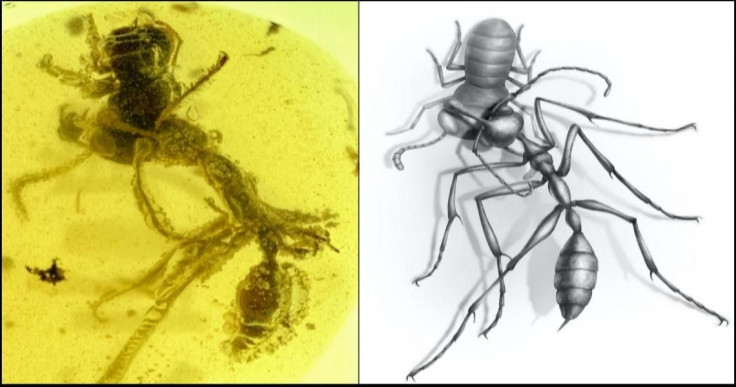99-Million-Year-Old Fossil Reveals Killer Feature Of 'Hell Ants'

KEY POINTS
- An amber recovered from Myanmar captured the moment a hell ant grasped its victim
- It helped researchers confirm how hell ants use their mouthparts
- Why they went extinct after millions of years of being successful remains a mystery
Researchers unveiled a 99-million-year-old amber that captured the moment that a "hell ant" grasped its victim using its horn-like mandibles. Thanks to the amber, the researchers were able to confirm how hell ants used their unique mandibles.
Hell ants from the Cretaceous period are among the earliest ants known to science. They are known for their unique scythe-shaped mandibles and the horn-like appendages on what would be their forehead. These are features that researchers say can no longer be found in any other living species.
Despite having identified 16 hell ant species to date, they remain to be quite the mystery to scientists and this mystery includes how hell ants used their unique features.
"Since the first hell ant was unearthed about a hundred years ago, it's been a mystery as to why these extinct animals are so distinct from the ants we have today," study lead author Phillip Barden of the New Jersey Institute of Technology (NJIT) said in a news release.
In a new study, a team of researchers from NJIT, the Chinese Academy of Sciences and the University of Rennes in France had the unique opportunity to find out more about hell ants, thanks to a rare fossil that was recovered from Myanmar. This particular amber captured the very moment that a hell ant had grasped a Caputoraptor elegans, which is a relative of cockroaches.
Barden says such a fossil that displays behavior, particularly predation, is "exceedingly rare." By studying it, the researchers were able to confirm how hell ants used their mouthparts.
"Our findings confirm the hypothesis that hell ants captured other arthropods between mandible and horn in a manner that could only be achieved by articulating their mouthparts in an axial plane perpendicular to that of modern ants," the researchers wrote.
Compared to modern ants that move their mouthparts laterally, or side to side, hell ants moved their horn-like mandibles up and down to essentially pin their prey against the horn-like appendages.
Haidomyrmecine “hell ants” are a group of species known only from Cretaceous amber in Canada, France, and Myanmar. They are unlike any modern ants, have enigmatic (less so now!) jaws and horns on their head. pic.twitter.com/tPqF282zeW
— Phil Barden (@Haidomyrmex) August 6, 2020
The team was also able to confirm that hell ants belong to one of the earliest branches of the "ant evolutionary tree" and that the elongated horn feature evolved twice in hell ants.
But the question as to why hell ant species went extinct despite being quite successful for almost 20 million years remains. The predatory traits of hell ants are also believed to have vanished some 65 million years ago during the Cretaceous-Paleogene extinction event.
"Over 99% of all species that have ever lived have gone extinct," Barden said. "As our planet undergoes its sixth mass extinction event, it's important that we work to understand extinct diversity and what might allow certain lineages to persist while others drop out. I think fossil insects are a reminder that even something as ubiquitous and familiar as ants have undergone extinction."
The study is published in Current Biology.
© Copyright IBTimes 2025. All rights reserved.






















